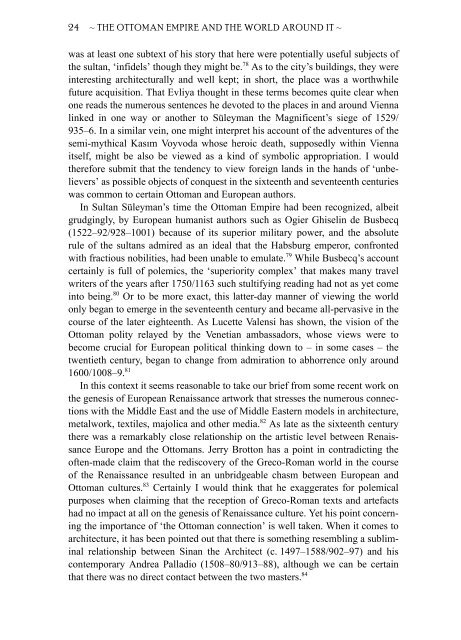The Ottoman Empire and the World Around It - Course Information
The Ottoman Empire and the World Around It - Course Information
The Ottoman Empire and the World Around It - Course Information
Create successful ePaper yourself
Turn your PDF publications into a flip-book with our unique Google optimized e-Paper software.
24 ~ THE OTTOMAN EMPIRE AND THE WORLD AROUND IT ~<br />
was at least one subtext of his story that here were potentially useful subjects of<br />
<strong>the</strong> sultan, ‘infidels’ though <strong>the</strong>y might be. 78 As to <strong>the</strong> city’s buildings, <strong>the</strong>y were<br />
interesting architecturally <strong>and</strong> well kept; in short, <strong>the</strong> place was a worthwhile<br />
future acquisition. That Evliya thought in <strong>the</strong>se terms becomes quite clear when<br />
one reads <strong>the</strong> numerous sentences he devoted to <strong>the</strong> places in <strong>and</strong> around Vienna<br />
linked in one way or ano<strong>the</strong>r to Süleyman <strong>the</strong> Magnificent’s siege of 1529/<br />
935–6. In a similar vein, one might interpret his account of <strong>the</strong> adventures of <strong>the</strong><br />
semi-mythical Kasım Voyvoda whose heroic death, supposedly within Vienna<br />
itself, might be also be viewed as a kind of symbolic appropriation. I would<br />
<strong>the</strong>refore submit that <strong>the</strong> tendency to view foreign l<strong>and</strong>s in <strong>the</strong> h<strong>and</strong>s of ‘unbelievers’<br />
as possible objects of conquest in <strong>the</strong> sixteenth <strong>and</strong> seventeenth centuries<br />
was common to certain <strong>Ottoman</strong> <strong>and</strong> European authors.<br />
In Sultan Süleyman’s time <strong>the</strong> <strong>Ottoman</strong> <strong>Empire</strong> had been recognized, albeit<br />
grudgingly, by European humanist authors such as Ogier Ghiselin de Busbecq<br />
(1522–92/928–1001) because of its superior military power, <strong>and</strong> <strong>the</strong> absolute<br />
rule of <strong>the</strong> sultans admired as an ideal that <strong>the</strong> Habsburg emperor, confronted<br />
with fractious nobilities, had been unable to emulate. 79 While Busbecq’s account<br />
certainly is full of polemics, <strong>the</strong> ‘superiority complex’ that makes many travel<br />
writers of <strong>the</strong> years after 1750/1163 such stultifying reading had not as yet come<br />
into being. 80 Or to be more exact, this latter-day manner of viewing <strong>the</strong> world<br />
only began to emerge in <strong>the</strong> seventeenth century <strong>and</strong> became all-pervasive in <strong>the</strong><br />
course of <strong>the</strong> later eighteenth. As Lucette Valensi has shown, <strong>the</strong> vision of <strong>the</strong><br />
<strong>Ottoman</strong> polity relayed by <strong>the</strong> Venetian ambassadors, whose views were to<br />
become crucial for European political thinking down to – in some cases – <strong>the</strong><br />
twentieth century, began to change from admiration to abhorrence only around<br />
1600/1008–9. 81<br />
In this context it seems reasonable to take our brief from some recent work on<br />
<strong>the</strong> genesis of European Renaissance artwork that stresses <strong>the</strong> numerous connections<br />
with <strong>the</strong> Middle East <strong>and</strong> <strong>the</strong> use of Middle Eastern models in architecture,<br />
metalwork, textiles, majolica <strong>and</strong> o<strong>the</strong>r media. 82 As late as <strong>the</strong> sixteenth century<br />
<strong>the</strong>re was a remarkably close relationship on <strong>the</strong> artistic level between Renaissance<br />
Europe <strong>and</strong> <strong>the</strong> <strong>Ottoman</strong>s. Jerry Brotton has a point in contradicting <strong>the</strong><br />
often-made claim that <strong>the</strong> rediscovery of <strong>the</strong> Greco-Roman world in <strong>the</strong> course<br />
of <strong>the</strong> Renaissance resulted in an unbridgeable chasm between European <strong>and</strong><br />
<strong>Ottoman</strong> cultures. 83 Certainly I would think that he exaggerates for polemical<br />
purposes when claiming that <strong>the</strong> reception of Greco-Roman texts <strong>and</strong> artefacts<br />
had no impact at all on <strong>the</strong> genesis of Renaissance culture. Yet his point concerning<br />
<strong>the</strong> importance of ‘<strong>the</strong> <strong>Ottoman</strong> connection’ is well taken. When it comes to<br />
architecture, it has been pointed out that <strong>the</strong>re is something resembling a subliminal<br />
relationship between Sinan <strong>the</strong> Architect (c. 1497–1588/902–97) <strong>and</strong> his<br />
contemporary Andrea Palladio (1508–80/913–88), although we can be certain<br />
that <strong>the</strong>re was no direct contact between <strong>the</strong> two masters. 84


